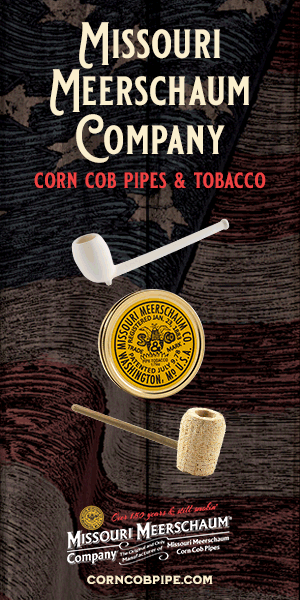Almost fifty years ago when I took vocational agriculture courses at Humansville High School (so I could join the FFA and get my own blue jacket) I learned something about beef prices in the grocery store I’ve never forgotten.
When beef cattle are slaughtered, they sell every atom of the animal.
But long, long ago the meat packers discovered formulas to price the choicest cuts higher by certain amounts, to where if a packer kills ten thousand steers a day every part from the tongue to filet mignon finds a buyer. Incidentally, the by products represent the profit of the packers.
Applying this to pipes, Lee had an identical problem to the meat packers.
Lee might use all the care he could to only buy the best briar, but briar comes in huge bags, and it makes expensive fuel for the shop stove. The idea is to sell every piece as a pipe, but there will be pieces more beautiful than others.
The last four years of the 1940s saw the most prosperous economy in the history of the nation, but also with that came inflation and labor shortages, and wage growth.
Whatever Lee paid in 1946 to produce pipes had escalated considerably by 1950, and the value of the dollars he received had declined. A $10 pipe in 1946 is worth $150 in our present day money, and in 1950 that $10 is only worth $121 today.
Kaywoodie had identical problems and cut the cost of production by cheapening the product, keeping prices more or less the same.
Lee had very early on discontinued his $3.50 One Star Grade (same as Drinkless) and only made $5 Two Stars, $10 Three Stars, $15 Four Stars, and the most expensive cataloged production pipe on earth, the $25 Five Star.
About 1950, Lee changed over the 7 pointed gold inlaid stars (that resemble asterisks) to a true five pointed gold inlaid star, that looks like a star, and raised prices to five dollars per star (still no One Stars)
The Two Star doubled in price, the Three Star went up a third, the Four Star went up 25%, and the top Five Star stayed the same.
A Three Star Lee is by far the most commonly found today, from all three eras.
But the fairly rare Two Stars are mostly found in the 5 pointed star era. Most Lee customers paid the extra five bucks for the same Three Star, but some kept on sending in $10 and were content with a lower grade pipe.
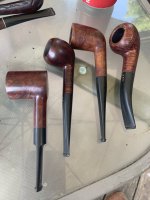
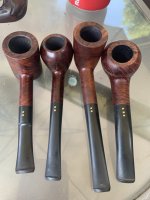
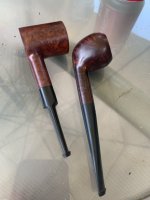
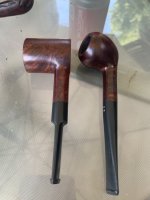
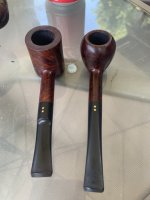 Most days I think a 5 pointed star era Lee is just a little better than the early 7 pointed star era pipes, but they are all so wonderful it’s impossible to say for certain.
Most days I think a 5 pointed star era Lee is just a little better than the early 7 pointed star era pipes, but they are all so wonderful it’s impossible to say for certain.
But Lee didn’t cheapen the product when he increased prices. At the minimum, quality standards remained the same.
When beef cattle are slaughtered, they sell every atom of the animal.
But long, long ago the meat packers discovered formulas to price the choicest cuts higher by certain amounts, to where if a packer kills ten thousand steers a day every part from the tongue to filet mignon finds a buyer. Incidentally, the by products represent the profit of the packers.
Applying this to pipes, Lee had an identical problem to the meat packers.
Lee might use all the care he could to only buy the best briar, but briar comes in huge bags, and it makes expensive fuel for the shop stove. The idea is to sell every piece as a pipe, but there will be pieces more beautiful than others.
The last four years of the 1940s saw the most prosperous economy in the history of the nation, but also with that came inflation and labor shortages, and wage growth.
Whatever Lee paid in 1946 to produce pipes had escalated considerably by 1950, and the value of the dollars he received had declined. A $10 pipe in 1946 is worth $150 in our present day money, and in 1950 that $10 is only worth $121 today.
Kaywoodie had identical problems and cut the cost of production by cheapening the product, keeping prices more or less the same.
Lee had very early on discontinued his $3.50 One Star Grade (same as Drinkless) and only made $5 Two Stars, $10 Three Stars, $15 Four Stars, and the most expensive cataloged production pipe on earth, the $25 Five Star.
About 1950, Lee changed over the 7 pointed gold inlaid stars (that resemble asterisks) to a true five pointed gold inlaid star, that looks like a star, and raised prices to five dollars per star (still no One Stars)
The Two Star doubled in price, the Three Star went up a third, the Four Star went up 25%, and the top Five Star stayed the same.
A Three Star Lee is by far the most commonly found today, from all three eras.
But the fairly rare Two Stars are mostly found in the 5 pointed star era. Most Lee customers paid the extra five bucks for the same Three Star, but some kept on sending in $10 and were content with a lower grade pipe.




 Most days I think a 5 pointed star era Lee is just a little better than the early 7 pointed star era pipes, but they are all so wonderful it’s impossible to say for certain.
Most days I think a 5 pointed star era Lee is just a little better than the early 7 pointed star era pipes, but they are all so wonderful it’s impossible to say for certain.But Lee didn’t cheapen the product when he increased prices. At the minimum, quality standards remained the same.






